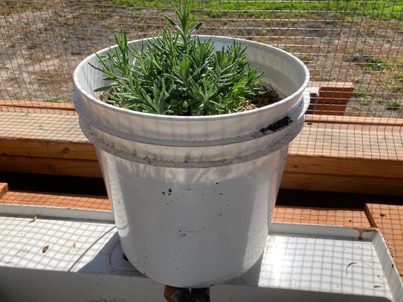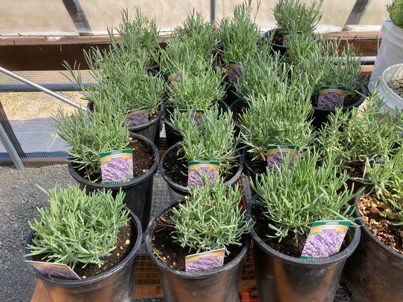Lavender in Containers
Growing lavender in containers is not ideal. However, lavender planted in containers will grow best by addressing lavender’s five basic requirements. Don’t be discouraged if your lavender does not thrive as a potted plant. Regardless of your best efforts, lavender prefers growing in the ground outdoors under full sunlight. The following tips should improve your chances of success when growing lavender in containers. Click on Container Lavender for a PDF copy of this page.
- Lavender Cultivar – Choose a compact or dwarf lavender cultivar (10-20 inches tall) from English (Lavandula angustifolia), Spanish (Lavandula stoechas), or fernleaf (Lavandula multifida) species. The following cultivars are just a few of the many available choices. Smaller compact English lavender cultivars include Munstead, Hidcote, Rosea, Melissa Lilac, and Buena Vista. Castilliano, a Spanish lavender cultivar, gets to 14″ tall with either white, lilac, or rose flowers. Spanish Eyes, a fernleaf lavender cultivar, has blue flowers and grows to 18″ tall.
. - Container Selection – Plant lavender in a terra cotta or clay pot with a diameter 2 inches larger than the lavender’s root ball and an ample number of holes in the bottom to provide good drainage. Pots that are too large result in excessive soil dampness and thus increase the opportunity for root disease. Porous clay pots provide insulation from hot and cold drafts, enhance air flow through the root zone, and lose excess moisture through the pot’s sides.
. - Potting Soil – Use a well-draining soil such as Sunshine Mix #4, cactus potting mix, or your favorite premium potting soil mixed with 50% perlite. Lavender prefers soil with a pH between 6.5 and 7.5. Mix one tablespoon of garden lime into the soil to slightly increase the alkalinity. To maintain a neutral to alkaline soil, add one tablespoon of crushed or ground egg shells to the soil surface per month.
. - Light – Lavender requires 8-10 hours of full sun per day. A supplemental grow light is needed if your home can’t provide sufficient sunlight. Full-spectrum daylight LED grow lights provide 5000k. The fixture should be suspended 12 inches or more from the potted plant. A timer connected to the fixture will control the light duration appropriate to seasonal day length.
. - Watering – Lavender thrive in well-drained soils and prefer to be slightly dry between waterings. Cultivar, plant size, pot size, temperature, and other factors affect watering needs. So check soil moisture every few days by inserting your finger or a soil moisture meter 1-3 inches into the pot. More succulent cultivars, such as fernleaf lavender, will require more frequent watering as indicated by wilted foliage. If the soil is dry or foliage wilted then water around the base of the plant until it drains completely out the pot’s bottom holes into the drainage pan. Do not allow water to remain in the pan. Watering too frequently or letting the soil remain too wet can lead to root rot. Rotate the pot a 1/4 turn after each watering to re-orient the plant to the light and encourage even growth on all sides.
. - Fertilizing – Lavender prefer low to moderately fertile soil. Fresh potting soil typically includes a small amount of fertilizer. However, prior to re-potting add 1 tablespoon of bone meal to the soil and thoroughly mix. Bone meal, an organic fertilizer, has slow release phosphorus which will promote root and flower development. In addition, to insure a healthy well-blooming plant you could add an all-purpose, water soluble or liquid fertilizer at half strength every four weeks during spring and summer. Closely monitor your plant’s health and follow the manufacturer’s instructions for monthly feeding.
. - Temperature/Humidity/Air Circulation – Indoor potted lavender require good air circulation which is provided by open windows during the summer and/or ceiling/table fans on low settings. Pots should not be placed near forced air vents with hot or cold air flow. During the growing season keep indoor temperatures between 65℉ to 80℉ during the day. Lavender go dormant during the winter months and should be placed in a room that’s cooler than the rest of the house. Aim to keep roots alive by watering throughout the winter and providing light with duration adjusted to seasonal day length, but don’t fertilize to encourage new growth. Lavender prefers a dry environment with humidity 40% or less.
. - Harvesting – When and if you harvest depends on your cultivar and intended use. To harvest English lavender cultivars, cut the flower stems with a sharp pair of scissors or pruners. We harvest at the first sign of flowering to maximize the amount of essential oils in the buds for fresh bouquets, and enhance bud retention for dried bouquets. Cut low enough to get long flower stems leaving at least 2 inches of green foliage above the woody stems. Typically you will not harvest flowers from container grown Spanish and fernleaf cultivars. If you don’t harvest then dead head the spent flowers to promote subsequent flowering.
. - Pruning – After planting lavender remove flowers to re-direct the plant’s resources to root growth. Also, prune branch tips 1-2 inches to encourage new growth and increase bushiness. Every September English lavender cultivars should be pruned in preparation for dormancy. Branches are cut leaving 2 inches of green foliage above the woody stems. Dead and low hanging branches should also be cut to promote better air circulation and prevent disease This annual pruning slows down woody stem growth and promotes new stem growth which produces better foliage and flowering. Be careful not to cut into the woody part of the plant. Spanish and fernleaf cultivars, however, should be carefully pruned throughout the growing season to maintain plant size and shape.
. - Moving Outdoors – In the spring potted indoor lavender plants can be moved to the outdoor patio for the summer when all danger of frost has passed. However, indoor plants need time to acclimate to the outside environment. To avoid shock slowly harden your indoor lavender to outdoor temperatures and direct sunlight over a 2 week period. Start by leaving the plant outdoors during the day and bring it indoors at night. Don’t forget to locate the pot in a place that receives 8-10 hours of full sun per day. Also, check soil moisture every day and water when slightly dry. When fall returns remember to move the potted lavender indoors before the first frost. Please note that if you intend to out-plant your container lavender that English cultivars are hardy within USDA hardiness zones 5-9, while Spanish and fernleaf cultivars are hardy within zones 7-11.



